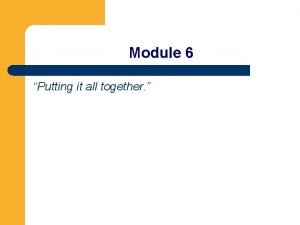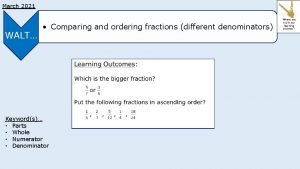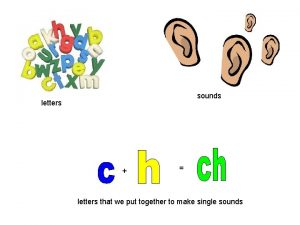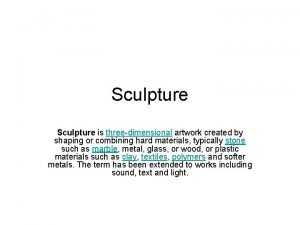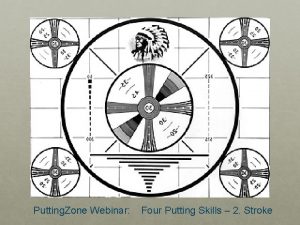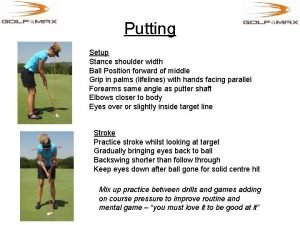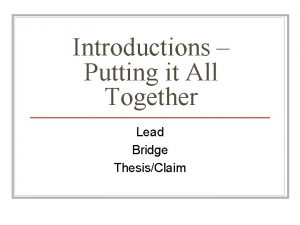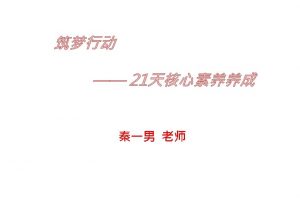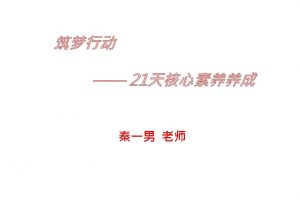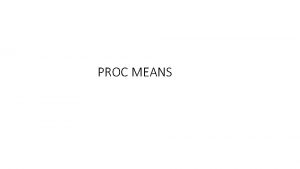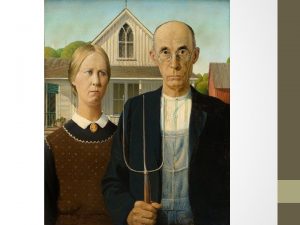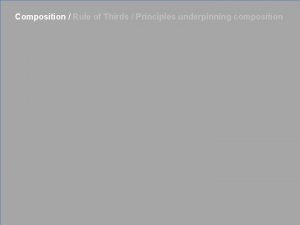Composition Part 1 The term composition means putting
































- Slides: 32

Composition Part 1

The term composition means 'putting together‘. Any work of art is arranged or “put together” using conscious thought in order to communicate an idea. Composition Involves: • The Picture Plane: the space you have to work with. • Arranging Forms and Imagery: Placing things in an interesting manner on the picture plane. • Selection: Choosing forms and imagery that will contribute to the concept of your artwork. • It is the STRUCTURE OF A PICTURE – how the elements are laid out in the frame. • How YOU select and organize lines, shapes, value, etc…. AND how you use the Elements of Art and Principles of Design!

1) Compose around a Single Center of Interest. Before shooting your photo, ask yourself what major element in the shot communicates your basic idea.

Compose around a Single Center of Interest. • You can isolate the subject by throwing the background out of focus. • Our eyes are attracted to areas with sharp focus.

Compose around a Single Center of Interest.

• However, when everything is in sharp focus, the image becomes cluttered and won't hold the viewer's attention. • Having too many things to look at causes fatigue in the viewer's eye.

2) Fill the Frame (tight framing): • Zoom in • Move in with your feet - get closer

Fill the FRAME

3) Rule of Thirds • Brake the frame into thirds, horizontally and vertically • Create a grid with intersecting points where your eyes naturally tend to look.

Rule Of Thirds: Dividing the picture plane into 3 parts. Horizontally and vertically • The rule of thirds is the best known composition rule. If you divide the image into thirds, objects should be placed where thirds cross. – Avoid placing the focal point in the center of the frame. (Bull’s Eye Syndrome)

Rule of Thirds




4) Framing: – Direct the viewers attention to the primary subject – Creates the illusion of depth – Can obscure unwanted objects in foreground/background – Can be naturally occurring – Tight framing – Wide framing – Using an object as a frame

4) FRAMING In order to draw attention to your subject, try creating a natural frame around the subject within your image.



Leading Lines • Lines are a design element that help direct your viewer through the image. • Establish a focal point, use lines to guide the viewer through your composition and keep them in the frame.

5) Disappearing Lines into Corners/Diagonals: • If there are strong lines in the scene, try to get them to disappear into the corner. If the lines break into the center or the edge, it tends to divide the picture. A disappearing line into a corner seems to make composition stronger.


6) S CURVES • The eye enjoys following S curves. • Creates movement


7) Vertical Lines: • Create a feeling of height • Suggest strength

8) Curved Lines: Suggest beauty, fluidity, grace, movement

Curved Lines: Movement and depth


Curved Lines: Suggest openness and space

9) Dominant Foreground/ Contributing Background


10) Silhouette: • Conveys drama, mood, mystery • Simplifies a busy composition • Place your subject(s) in front of an interesting light source

Silhouette
 Organizational method in speech
Organizational method in speech Practice putting it all together
Practice putting it all together Putting-out system
Putting-out system What does nasreen say about ice cream with chocolate
What does nasreen say about ice cream with chocolate When was the loom invented
When was the loom invented Proletarianization ap euro
Proletarianization ap euro After putting the pieces together, what do they look like?
After putting the pieces together, what do they look like? Non physical fences example
Non physical fences example Putting objects in perspective
Putting objects in perspective Oncology nursing society putting evidence into practice
Oncology nursing society putting evidence into practice The order of putting on ppe
The order of putting on ppe Putting it all together motion answer key
Putting it all together motion answer key Ordering fractions
Ordering fractions Putting people first 2007
Putting people first 2007 Putting-out system
Putting-out system Classification of polynomials according to degree
Classification of polynomials according to degree Putting the enterprise into the enterprise system
Putting the enterprise into the enterprise system Put sounds together
Put sounds together A 3-d work of art created by shaping or combining materials
A 3-d work of art created by shaping or combining materials Putting zone
Putting zone Putting to death the old man
Putting to death the old man Putting the enterprise into the enterprise system
Putting the enterprise into the enterprise system Putter stance setup
Putter stance setup Package mypackage; class first { /* class body */ }
Package mypackage; class first { /* class body */ } Putting it into practice
Putting it into practice Putting prevention into practice
Putting prevention into practice Putting on the new man
Putting on the new man Putting two words together
Putting two words together Introduction bridge examples
Introduction bridge examples Putting it all together
Putting it all together Putting it all to bed during project closeout includes
Putting it all to bed during project closeout includes Putting principles into practice
Putting principles into practice Putting the pieces together case study answer key
Putting the pieces together case study answer key

